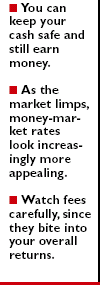Article
Investment Consult
Money markets: Worth another look
In recent years, money-market funds have been a barely-better-than-nothing place to park your cash. You'd get safety and liquidity, and you could eke out some extra dollars that sometimes didn't really add up to much.

Money-market funds invest in short-term securities that, on average, mature in less than 91 days. These securities include Treasury bills, negotiable certificates of deposit, and other very short-term loans, all of which typically have minimal risk of default. Money-market fund managers keep the net asset value of shares at $1, to maintain the stable value of your money.
Since many investment gurus are predicting market returns in the 6 to 8 percent range over the next few years, 4 percent on a money-market fund is not too shabby! And, unlike with the stock market, there's virtually no risk.
Before you invest in a money-market fund, think about whether you want a taxable or tax-exempt account. Tax-exempt funds tend to invest in municipal bonds of a particular state, which means they're generally free from both federal and state taxes.
To evaluate a tax-exempt money-market fund, you need to look at its equivalent taxable yield. Subtract your income tax bracket from 100, and divide the fund's yield by that number. That's your equivalent taxable yield. For example, if you're in the 36 percent tax bracket, and a tax-exempt fund is paying 1.8 percent, divide 1.8 by 0.64, (100 minus 36) and you've got a taxable equivalent yield of 2.8 percent. So consider a taxable fund only if it earns more than 2.8 percent.
Yields on tax-exempt funds haven't been rising to the degree that they have on taxable accounts. For this reason, at this point I advise sticking with taxable accounts.
Next, shop around for rates. In general, they don't differ much, but even a quarter point or half point can add up. Fidelity Cash Reserves money-market fund has a seven-day yield of 3.5 percent, which is pretty standard these days. You can find some of the best money-market rates at http://www.ibcdata.com and http://www.bankrate.com.
With interest rates huddling so close to each other, fund expenses make a big difference. On the high side, Transamerica Premier Cash Reserve Fund charges expenses of 0.74 percent of assets, and on the lower side, there's Scudder's Government & Agency Money Fund at 0.43 percent and Fidelity Cash Reserves at 0.39 percent. Vanguard's Prime Money Market Fund expenses are lower still, at 0.32 percent. The fee, of course, reduces your total returns.





